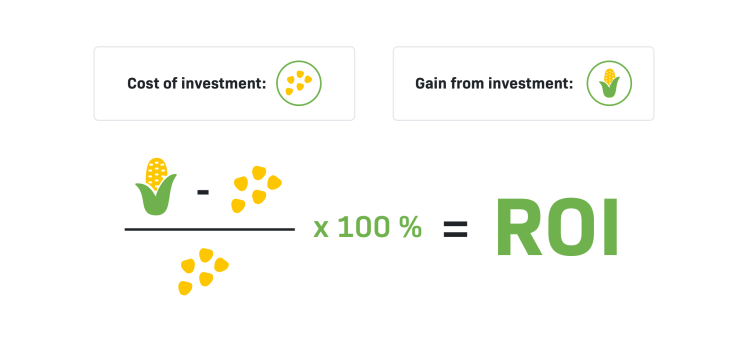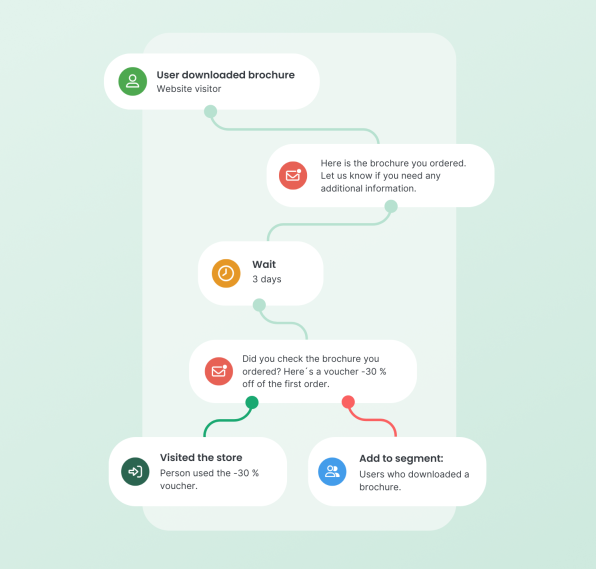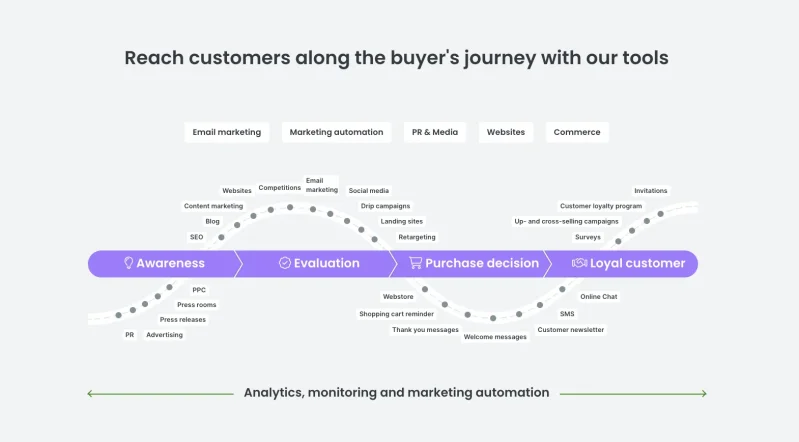Reviewing and analyzing your marketing efforts is important to ensure their effectiveness. By calculating the true value of your actions – or in other words, the value of marketing – you can address areas that need improvement or are inefficient, and concretely improve your marketing. A great tool for reviewing the value of your marketing is ROI (Return on Investment).
Does ROI sound like something that you want to master but you’re not sure how and where to start? In this article, we will cover everything you need to know, starting from what ROI is, how it’s calculated, and why it’s worth utilizing.
Quick course on ROI:
- What is ROI?
- What is a good ROI?
- Where does all the money go?
- How to use analytics as a foundation?
- How to calculate the efficiency ratio?
- What are the limitations of ROI?
1. What is ROI?
ROI comes from the words Return on Investment, meaning, it refers to the amount of money a company gets back from its investments. ROI shows the efficiency of your marketing efforts, or in other words, the value of marketing. In its simplest form, the formula for calculating ROI looks like this:

If, for example, a specific ad campaign has a total investment of 3,000 euros and it has generated 15,000 euros in additional sales, its ROI would be (15,000 − 3,000) ÷ 3,000 × 100% = 400%.
The ROI formula works best when you want to determine the value of short-term marketing campaigns, as the return percentage can be directly compared to previous figures. However, ROI can also be used to assess the effectiveness of marketing efforts in the long run. Additionally, ROI can be applied to find the marketing channels that best serve your company's needs.
It's important to note that the ROI figure is not static, and it should be recalculated regularly. This way, you can adapt your actions to suit each period and gain real benefit from the numbers you measure.
2. What is a good ROI?
In terms of marketing, you should aim for at least a 500% return. This is because the efficiency ratio does not include, for example, production costs, fixed company expenses, or personnel costs – it’s important to remember that the primary goal of a business, and therefore also marketing, is to generate profit.
Of all the modern marketing channels, email marketing has proven to be particularly effective: even a 675% ROI is achievable.
3. Where does all the money go?
When calculating the return percentage of marketing, the costs generally include:
- Social media advertising and Google ads
- Trade shows and events
- Marketing tools, such as a newsletter tool or automation tool
- Physical marketing materials such as flyers, posters, and pins
- Traditional media like radio ads, newspaper ads, and billboards
- Marketing and communications agencies, as well as consulting costs
It’s important to consider all your marketing channels when calculating ROI. If you leave some of them out of the equation, you might miss valuable data that could be useful in your organization’s marketing strategy.
4. How to use analytics as a foundation?
To calculate the ROI of marketing efforts, you first need data on the company’s revenues and investments. For example, Google Analytics and Matomo allow you to see sales revenue and other goals, and you can compare them to the value of the investment. For a bigger picture, you can bring data from different channels, such as your billing system, CRM, and online store, into your marketing automation system.
A comprehensive automation tool combines data from different channels, showing whether an unknown website visitor has eventually turned into a paying customer and which channels led them to you. This way, you can compare the investments in different marketing channels to the sales revenue generated through them.

There are also separate ROI tools available on the market that can be integrated with marketing and analytics tools to calculate your return percentage. For example, the Funnel tool calculates ROI based on your data, taking into account different countries' currencies and currency exchanges.
5. How to calculate efficiency?
When calculating the efficiency of different marketing channels, it’s important to first consider what is the key metric for your marketing efforts – what are you aiming to achieve? In a consumer-focused B2C company, the goal is direct purchases from customers, while in sales-oriented B2B organizations, marketing aims to generate valuable leads for the sales team. It’s crucial to consider the field in which your company operates when calculating efficiency.
When calculating ROI throughout the customer journey, it's important to focus on key metrics. Knowing the various contact points helps you define the metrics that apply to your business and marketing strategy.
Consider, for example, these questions:
- What is the average revenue from one lead?
- At what point does a newsletter subscriber or LinkedIn ad clicker become a lead forwarded to the sales team?
- What makes a potential customer, at the very beginning of their journey, interested enough to subscribe to a newsletter or click an ad?

Different technologies are used at various stages of the customer journey.
Defining the ROI of different channels can seem challenging, but it’s absolutely necessary. Here’s a good tip to simplify the process: when calculating the ROI of different channels, you need to step back along the customer journey and examine what percentage moved from the previous stage to the next.
This gives you a good overall picture of how effectively, for example, social media content marketing or paid advertising is converting into revenue.
6. What are the limitations of ROI?
ROI is a tool that shows you the concrete results of your marketing efforts and provides an overall view of the effectiveness of the actions taken. Like any tool, ROI also has its limitations, which are good to be aware of. A prime example is the inclusion of social media in the customer purchase journey. Potential customers may, for example, first see an ad on Instagram while browsing their phone but not convert immediately after seeing the ad.
Later, the same consumers might see the same ad on their desktop and decide to visit the company’s website without clicking the ad. Even if they make a purchase and complete the desired conversion, it cannot be tracked. Therefore, it’s important to combine data from different channels and follow the bigger picture in addition to ROI.
ROI also only considers monetary results. Marketing can also achieve other significant benefits, such as brand awareness and customer loyalty, which are more difficult to measure. These may not immediately bring monetary profit to the company, but they are extremely important for the company's success.
The metric also cannot predict the future: even if your marketing efforts are effective at the moment, they may not produce the same results in the future. However, by following analytics and using various scenario tools, you can determine where the ROI of different channels is headed and what could be the best investments going forward.
How can marketing automation support ROI calculation?
What are the possibilities of marketing automation, and how can you utilize it in calculating ROI? Contact us and check out our marketing automation guides to learn more about the topic.
Read more about measuring marketing and improving your skills on our blog:



